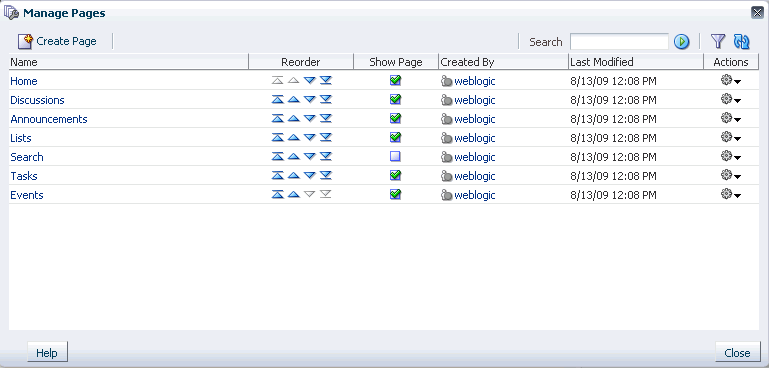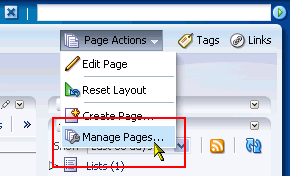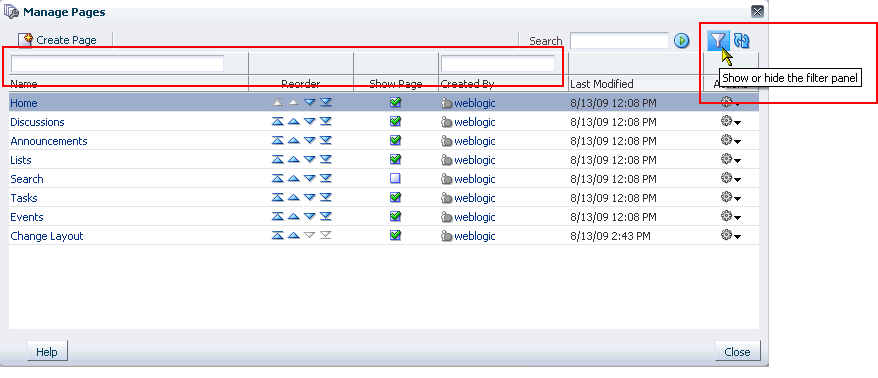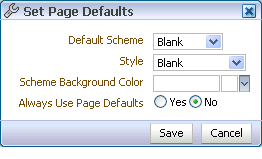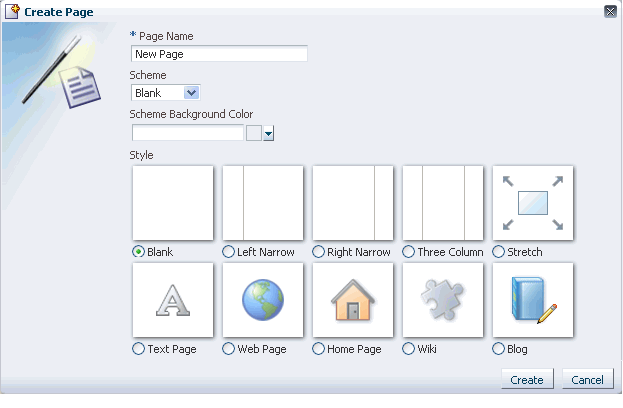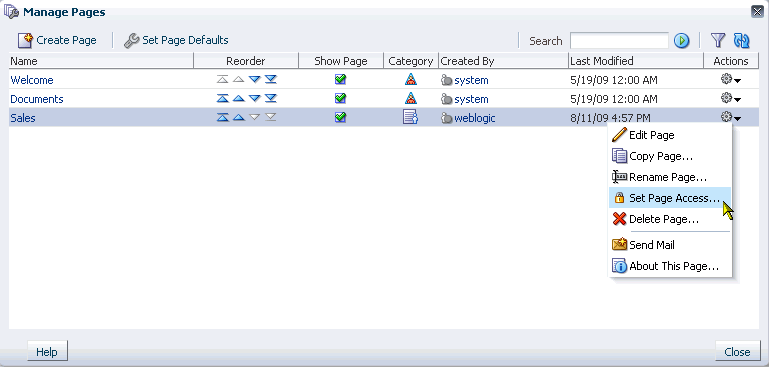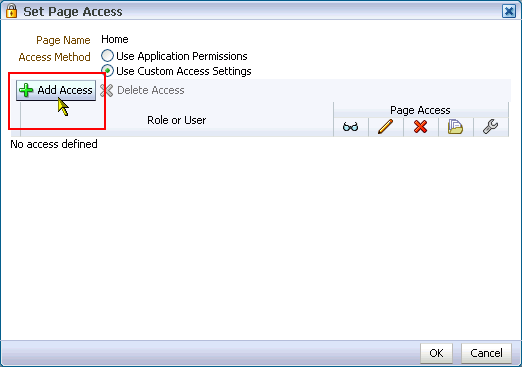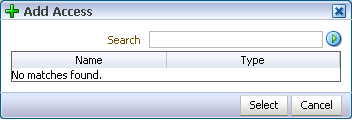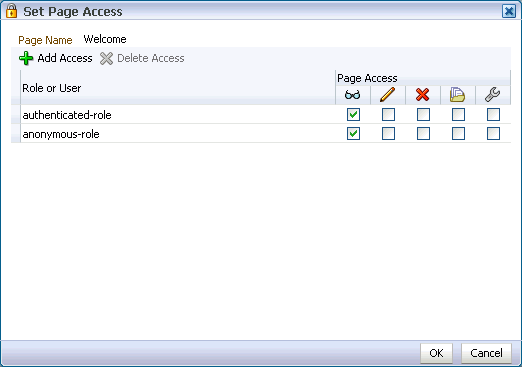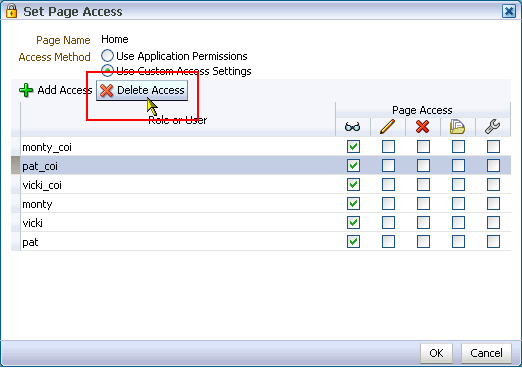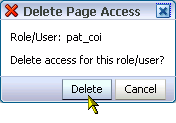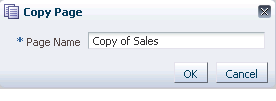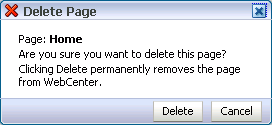7 Managing Pages
The WebCenter Spaces Manage Pages dialog (Figure 7-1) provides easy access to a wide variety of page-related actions. For example, use the dialog to personalize the display order of personal or group space pages; set page creation defaults (personal space pages only); apply page security; hide or show pages in your application view; and create, copy, and delete pages.
This chapter includes the following sections:
-
Section 7.1, "What You Should Know About the Manage Pages Dialog"
-
Section 7.4, "Changing the Order of Pages Through the Manage Pages Dialog"
-
Section 7.5, "Setting Page Creation Defaults for Your Personal Pages"
-
Section 7.6, "Creating a Page Through the Manage Pages Dialog"
-
Section 7.8, "Copying a Page Through the Manage Pages Dialog"
-
Section 7.9, "Entering Edit Mode Through the Manage Pages Dialog"
-
Section 7.10, "Deleting a Page Through the Manage Pages Dialog"
This chapter is intended for WebCenter Spaces users who intend to manage application pages. By default, every authenticated user can perform the actions described in this chapter on the pages they create in their own personal spaces. Note, however that your application administrator may alter default page access permissions. In group spaces, users must have sufficient access privileges on the group space to manage its pages.
7.1 What You Should Know About the Manage Pages Dialog
The Manage Pages dialog (Figure 7-2) provides quick access to pages and page-management controls.
These include:
-
Creating, editing, copying, and deleting pages
-
Hiding and showing pages in your view
-
Exposing a group space page in your personal space
-
Sending a page link through your native mail application
-
Rearranging your view of page display order
-
Setting page security (including making a page public)
-
Setting page creation defaults (personal space pages only)
-
Viewing information about a page, including its direct URL
The Manage Pages dialog is context-aware. When you open it, the dialog renders according to your location in the application. For example, in a group space, the Manage Pages dialog displays all of the pages in that group space. In your personal space, it displays all of the pages in your personal space; additionally, it provides a control for setting page creation defaults for the pages you create in your personal space (Figure 7-3).
Figure 7-3 The Set Page Defaults Button in the Manage Pages Dialog
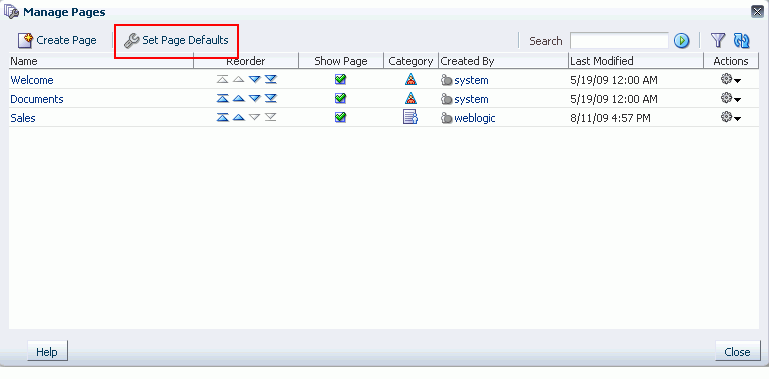
Description of "Figure 7-3 The Set Page Defaults Button in the Manage Pages Dialog"
The Manage Pages dialog provides access to the actions you can perform on a given page in its Actions column (Figure 7-4).
Figure 7-4 The Actions Column and Menu in the Manage Pages Dialog

Description of "Figure 7-4 The Actions Column and Menu in the Manage Pages Dialog"
Tip:
Actions performed from the Manage Pages dialog take effect when you close the dialog.The actions that appear on the Actions menu depend upon the page, the point from which the page is opened, and your permissions on the page.
Note:
Most of the actions available on the Actions menu are also available on the pages themselves. An active page—that is, the page currently on view—includes a menu icon with similar controls. You can open this menu from and inactive page by right-clicking the page tab. For more information, see Section 2.6, "Initiating Actions from Tabs." Section 2.6 covers tasks not covered in this chapter, including renaming a page, exposing a group space page in a personal space, and obtaining information about a page.You can also open pages from the Manage Pages dialog. Simply click the page name in the Name column, and the page opens in WebCenter Spaces. The Manage Pages dialog closes automatically.
7.2 Opening the Manage Pages Dialog
To open to the Manage Pages dialog:
-
Log in, and go to your personal space or the group space with pages you want to manage.
-
Open the Page Actions menu, and select the Manage Pages option (Figure 7-5).
The Manage Pages dialog opens (Figure 7-6).
Click the Close button to exit the dialog.
7.3 Finding Pages in the Manage Pages Dialog
The Manage Pages dialog includes two features for locating a page or group of pages in a personal or group space: search and filter. Both features render lists of pages that match your search or filter criteria.
This section describes how to use the search and filter features in the Manage Pages dialog. It contains the following subsections:
-
Section 7.3.1, "Searching for Pages in the Manage Pages Dialog"
-
Section 7.3.2, "Filtering Your View of Pages in the Manage Pages Dialog"
7.3.1 Searching for Pages in the Manage Pages Dialog
The Manage Pages dialog provides a search feature for quickly locating one or more pages of interest. Search results display in the dialog; click a result to open its associated page in WebCenter Spaces.
When you close the Manage Pages dialog, your search terms are automatically cleared. You can also clear them explicitly by clicking the Clear Search button.
To search for a page in the Manage Pages dialog:
-
Log in, go to your personal space or the group space you want to search, and open the Manage Pages dialog.
For information about opening the Manage Pages dialog, see Section 7.2, "Opening the Manage Pages Dialog."
-
Enter a full or partial search term in the Search field, and then click the Search icon (Figure 7-7).
Figure 7-7 The Search Field and Search Icon in the Manage Pages Dialog
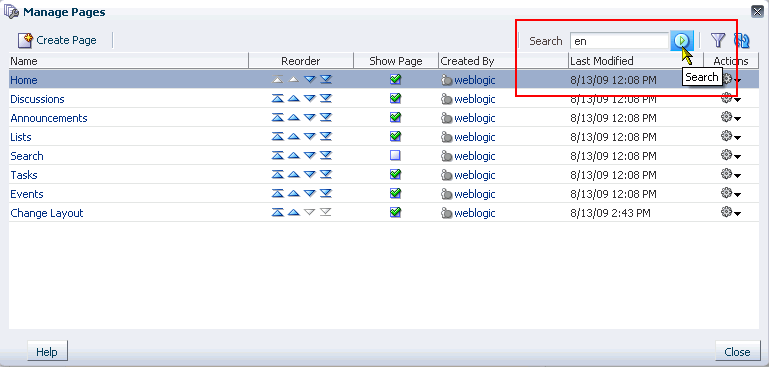
Description of "Figure 7-7 The Search Field and Search Icon in the Manage Pages Dialog"
Tip:
Search terms are not case sensitive.The Manage Pages dialog refreshes with all pages matching the search term.
-
Click the Clear Search icon next to the Search field to exit search and restore the dialog to its default view (Figure 7-8).
7.3.2 Filtering Your View of Pages in the Manage Pages Dialog
Filtering enables you to locate pages by name and by the user name of the person who created them. In the Manage Pages dialog, the Show or hide the filter panel icon is a toggle switch you click both to open and close the filter panel (Figure 7-9).
When you close the Manage Pages dialog, your filtering terms are automatically cleared. You can also clear them explicitly by deleting your terms from the Filter panel and pressing Enter.
To locate a page by filtering the list of pages in the Manage Pages dialog:
-
Log in, go to your personal space or the group space in which to locate a page, and open the Manage Pages dialog.
For information about opening the Manage Pages dialog, see Section 7.2, "Opening the Manage Pages Dialog."
-
Click the Show or hide the filter panel icon.
-
In the resulting filter panel, enter a full or partial filtering term in either or both fields above the Name and Created By columns, and press Enter.
Tip:
Filtering terms are not case sensitive.The Manage Pages dialog refreshes with all pages matching the filtering term(s).
To return the Manage Pages dialog to its default mode, delete your filtering terms and press the Enter key. To close the filter panel, click the Show or hide the filter panel icon.
7.4 Changing the Order of Pages Through the Manage Pages Dialog
By default, pages are arranged in the order they are created. You may want to rearrange the default order, adding emphasis to more critical pages by placing them earlier in the succession of tabs. Such changes are personalizations in that they affect only your view of page order.
See Also:
Group spaces provide controls that enable group space administrators to reorder group space pages for everyone. For more information, see Section 13.5, "Managing Group Space Pages."To change the order of pages through the Manage Pages dialog:
-
Log in, go to your personal space or the group space in which to change the display order of pages, and open the Manage Pages dialog.
For information about opening the Manage Pages dialog, see Section 7.2, "Opening the Manage Pages Dialog."
-
In the Reorder column, click the up arrow next to a page to move the page higher in the page order (the page's tab is moved closer to the start of tab order); or click the down arrow next to a page to move the page lower in the page order (the page's tab is moved further from the start of tab order).
Alternatively, click and hold a page row, and drag and drop it to the desired position.
-
Click the Close button when you finish reordering pages.
Pages are rendered in the order you specified.
7.5 Setting Page Creation Defaults for Your Personal Pages
Use page creation options to predetermine the values to use in creating pages in your personal space. Normally, when you create a page you are prompted to provide values for the page scheme and page template. Using page creation options, you can specify default values for scheme and template and consequently skip making those selections during page creation.
You can set page creation options for yourself so that every page you create in your personal space uses the same defaults. An administrator can set page creation options for all users' personal spaces. The settings you establish for yourself override any settings an administrator may provide.
See Also:
For information about setting up personal space page creation options for the application, see the "Setting Up a Default Look and Feel for Personal Pages" section in the Oracle Fusion Middleware Administrator's Guide for Oracle WebCenter.The page creation options you set through the Manage Pages dialog influence all the pages you create in your personal space, whether you create them through the Manage Pages dialog or through some other page creation mechanism.
This section provides an overview of default page styles and schemes and describes how to set page creation defaults for your personal space. It includes the following subsections:
-
Section 7.5.1, "Introducing Default Page Schemes and Styles"
-
Section 7.5.2, "Setting Page Creation Defaults for Personal Pages"
7.5.1 Introducing Default Page Schemes and Styles
This section provides two tables that illustrate default page schemes and styles:
Table 7-1 illustrates how each scheme selection looks on a blank page. Note that each scheme selection also provides font and color styles that are not evident on an unpopulated page.
Table 7-2 illustrates and describes each style selection.
Users with the relevant level of permissions can switch some page layouts (styles) at runtime. In addition to illustrating different page layouts, Table 7-2 also indicates which layouts can and cannot be switched at runtime.
Note:
For information about switching page layouts at runtime, see Section 4.2.2, "Changing Your Page Layout" (personalization) and Section 8.4.3, "Changing Everyone's Page Layout" (customization).| Name | Illustration | Description |
|---|---|---|
|
|
A one-column page with one layout box into which you can add content. When you edit this page, a Change Layout link is provided to enable you to change the number and configuration of layout boxes on the page. For more information, see Section 8.4.3, "Changing Everyone's Page Layout." Note that a Change Layout link may also be available in page view mode. When you change page layout in page view mode, it is a personalization affecting only your view of the page. For more information, see Section 4.2.2, "Changing Your Page Layout." |
|
|
|
A two-column page with two layout boxes into which you can add content. Layout boxes are positioned side-by-side, with the narrower layout box on the left. When you edit this page, a Change Layout link is provided to enable you to change the number and configuration of layout boxes on the page. For more information, see Section 8.4.3, "Changing Everyone's Page Layout." Note that a Change Layout link may also be available in page view mode. When you change page layout in page view mode, it is a personalization affecting only your view of the page. For more information, see Section 4.2.2, "Changing Your Page Layout." |
|
|
|
A two-column page with two layout boxes into which you can add content. Layout boxes are positioned side-by-side, with the narrower layout box on the right. When you edit this page, a Change Layout link is provided to enable you to change the number and configuration of layout boxes on the page. For more information, see Section 8.4.3, "Changing Everyone's Page Layout." Note that a Change Layout link may also be available in page view mode. When you change page layout in page view mode, it is a personalization affecting only your view of the page. For more information, see Section 4.2.2, "Changing Your Page Layout." |
|
|
|
A three-column page with three layout boxes into which you can add content. Layout boxes are positioned side-by-side, with the narrower layout boxes on the left and right sides. When you edit this page, a Change Layout link is provided to enable you to change the number and configuration of layout boxes on the page. For more information, see Section 8.4.3, "Changing Everyone's Page Layout." Note that a Change Layout link may also be available in page view mode. When you change page layout in page view mode, it is a personalization affecting only your view of the page. For more information, see Section 4.2.2, "Changing Your Page Layout." |
|
|
|
A page dedicated to the display of one task flow. Any task flow you place on this page is maximized, taking up all available space. For an example of a page based on the Stretch style, see the Documents page or the Announcements page in your WebCenter Spaces application. This page style cannot be changed when you edit the page. |
|
|
|
A page with a seeded Text component (that is, a Rich Text Editor), which you can use to enter and apply styles to text. For information about the Rich Text Editor, see Section 18.4.3.3, "Creating and Editing Rich Text Documents." When you edit this page, a Change Layout link is provided to enable you to change the number and configuration of layout boxes on the page. For more information, see Section 8.4.3, "Changing Everyone's Page Layout." Note that a Change Layout link may also be available in page view mode. When you change page layout in page view mode, it is a personalization affecting only your view of the page. For more information, see Section 4.2.2, "Changing Your Page Layout." |
|
|
|
A page that takes a URL value, enabling you to expose external web content in your WebCenter Spaces application. For more information, see Chapter 30, "Working with Wikis and Blogs" This page style cannot be changed when you edit the page. |
|
|
|
A preseeded Home page, based on the Right Narrow Column Layout page style. The Home page style comes prepopulated with task flows and other content. When you edit this page, a Change Layout link is provided to enable you to change the number and configuration of layout boxes on the page. For more information, see Section 8.4.3, "Changing Everyone's Page Layout." Note that a Change Layout link may also be available in page view mode. When you change page layout in page view mode, it is a personalization affecting only your view of the page. For more information, see Section 4.2.2, "Changing Your Page Layout." |
|
|
|
A page preconfigured to expose wiki controls from the Oracle WebCenter Wiki and Blog Server. This page style becomes available in the Create Page dialog when the server is integrated with WebCenter Spaces. This page style cannot be changed when you edit the page. |
|
|
|
A page preconfigured to expose blog controls from the Oracle WebCenter Wiki and Blog Server. This page style becomes available in the Create Page dialog when the server is integrated with WebCenter Spaces. |
7.5.2 Setting Page Creation Defaults for Personal Pages
To set page creation defaults for your personal space:
-
Log in, go to your personal space, and open the Manage Pages dialog.
For information about opening the Manage Pages dialog, see Section 7.2, "Opening the Manage Pages Dialog."
-
Click the Set Page Defaults button (Figure 7-10).
The Set Page Defaults dialog opens (Figure 7-11).
-
Set your page defaults:
-
Select a design scheme for new pages from the Default Scheme dropdown list.
For an illustration of each scheme, see Table 7-1, "Seeded Page Schemes".
-
Select a layout from the Style dropdown list.
For an illustration and description of each style, see Table 7-2, "Seeded Page Styles".
-
Select a page background color from the Scheme Background Color dropdown list.
-
If you selected Custom from the Default Scheme dropdown list, enter the URL to the image to use for the custom scheme in the Scheme Background Image field.
Enter for example:
http://mycompany.com/images/chinwig/cologo_small.gif
This field appears only when Custom is selected from the Default Scheme dropdown list.
-
Select an option next to Always Use Page Defaults:
Yes—When you create pages in your personal space, skip the Create Page dialog, and create the page using the defaults you set here.
No—When you create pages in your personal space, have the defaults you set here preselected in the Create Page dialog.
-
-
Click Save to save your changes and exit the dialog.
Going forward, when you create pages in your personal space, the defaults you set here determine the scheme and style that are preselected for the new page and whether the Create Page dialog opens.
7.6 Creating a Page Through the Manage Pages Dialog
The Manage Pages dialog provides a means of creating new pages in personal and group spaces. Page creation through the Manage Pages dialog can be affected by whether you are creating a page in a personal space or a group space.
When you create a page in a personal space, either a page is instantly created or the Create Page dialog opens and presents options for determining the page layout and scheme and the scheme background color. What happens is influenced by the default page creation options you select (for more information, see Section 7.5, "Setting Page Creation Defaults for Your Personal Pages").
In a group space, the Create Page dialog always opens.
This section describes page creation as it occurs when the Create Page dialog opens.
See Also:
The Manage Pages dialog provides one way to create pages. Learn another way in Chapter 8, "Creating, Editing, and Deleting Pages."To create a page through the Manage Pages dialog:
-
Log in, go to your personal space or the group space in which to create a page, and open the Manage Pages dialog.
For information about opening the Manage Pages dialog, see Section 7.2, "Opening the Manage Pages Dialog."
-
Click the Create Page button.
If your default page creation page options are preset to omit prompting you with page creation options, the page is created without further steps (for more information, see Section 7.5, "Setting Page Creation Defaults for Your Personal Pages").
Otherwise, the Create Page dialog opens (Figure 7-12).
-
In the Create Page dialog, enter a display name for the page in the Page Name field.
The name you enter here appears on the page's tab and in the Manage Pages dialog.
-
Optionally, from the Scheme dropdown list, select a scheme for the page.
The scheme provides a seeded background image or enables you to select your own background image. For illustrations of seeded schemes, see Table 7-1.
-
Optionally, pick a background color for the page from the Scheme Background Color dropdown list.
-
If you selected Custom from the Scheme dropdown list, enter the URL to the custom image you want to use for your page background in the Scheme Background Image field.
Enter, for example:
http://mycompany.com/images/chinwig/cologo_small.gif
This field appears only when Custom is selected from the Default Scheme dropdown list.
-
Select the style you want to apply to the new page.
For an illustration and description of each page style, see Table 7-2.
-
Click the Create button.
The page is created and immediately displayed in edit mode in Oracle Composer. From here, you can add files, task flows, and other types of content and share your information with others.
See Also:
After you create a page, the following sections may be useful to you as you take your next steps:-
For information about adding layout components, see Chapter 9, "Working with Page Layout Components."
-
For information about adding files, see Section 10.1.3, "Adding Documents to a Page."
-
For information about adding task flows, see Section 10.1.4, "Adding Task Flows to a Page."
-
For information about adding portlets to a page, see Section 10.1.5, "Adding Portlets to a Page."
-
7.7 Setting and Revoking Page Access Permissions
Within a given personal or group space, you can assign different page access privileges to different users or user roles. For example, you can share page management access with a coworker who is jointly leading a particular effort. You may want to give customization access to your team, or editorial access to a colleague who normally would only be able to view the page.
You can use the page access settings available through the Manage Pages dialog to provide page access to a select list of specified users and user roles. You can also use page access settings to make a page publicly available.
This section describes how to configure custom page access. It contains the following subsections.
Note:
By default, all group space pages are automatically visible to all group space members. Using the procedure described in this section, you can set explicit access on a group space page to restrict it to a set of users or roles.See Also:
Making a group space or a group space page publicly accessible is an administrative function. For more information, see Section 13.12.3, "Granting Public Access to a Group Space."7.7.1 Setting Custom Page Access
To configure custom page access through the Manage Pages dialog:
-
Log in, go to your personal space or the group space in which to configure custom page access, and open the Manage Pages dialog.
For information about opening the Manage Pages dialog, see Section 7.2, "Opening the Manage Pages Dialog."
-
In the Actions column, click the Actions icon in the row of the page on which to set access and select Set Page Access from the resulting menu (Figure 7-13).
The Set Page Access dialog opens.
-
For group space pages only, select from:
-
Use Application Permissions to have page access handled by permissions set at the application level. If you select this option, skip to step 10.
-
Use Custom Access Settings to set custom access on the current page.
These options are provided for group space pages only. They do not appear in the Set Page Access dialog for pages in a personal space.
-
-
Click the Add Access button (Figure 7-14).
The Add Access dialog opens (Figure 7-15).
-
In the Search field, enter the name of the user or role for whom you want to define page security, and click the Search icon.
Optionally, enter a search term of at least two characters, and click the Search icon.
-
Select a user name or role by clicking its row.
To make multiple selections:
-
Ctrl-Click to select multiple rows.
-
Shift-Click to select a range of rows.
When you select a user name, the permissions you set are granted to that specific user. When you select an enterprise group or application role, the permissions you set are granted to all users who are members of that group or assigned that role.
-
-
Click the Select button.
The Add Access dialog closes, and the Set Page Access dialog populates with the selected users (Figure 7-16).
-
Repeat steps 4 through 7 to add all the users and roles of interest to the Set Page Access dialog.
-
For each role or user, set custom access by selecting one or more access privileges from the Page Access columns.
By default, all authenticated users and user roles are granted page view access. The other access privileges require page view access.
Table 7-3 lists and describes the access privileges available from the Page Access column in the Set Page Access dialog.
Table 7-3 Page Access Privileges in the Set Page Access Dialog
Icon Name Description 
View Page
User or role can access the page for viewing, but cannot perform any other actions on the page.

Edit Page
User or role can edit the page using Oracle Composer. This includes adding, rearranging, and deleting content; renaming the page; and changing page properties, such as the page scheme.

Delete Page
User or role can delete the page.

Perform All Page Actions
User or role can perform all actions on the page.

Personalize Page
User or role can rearrange page content and personalize their view of task flows, provided the task flow includes personalization settings.
-
Click OK to save your changes and close the Set Page Access dialog.
-
Click Close to exit the Manage Pages dialog.
Note:
Page access permissions set through the Manage Pages dialog take effect when you click OK.Page access permissions set through the Page Properties dialog in Oracle Composer are committed immediately. Closing Oracle Composer without saving does not discard such changes.
7.7.2 Making a Personal Page Public
To make a personal page public:
-
Log in, go to your personal space, and open the Manage Pages dialog.
For information about opening the Manage Pages dialog, see Section 7.2, "Opening the Manage Pages Dialog."
-
In the Actions column, click the Actions icon in the row of the page to make public and select Set Page Access from the resulting menu (Figure 7-17).
The Set Page Access dialog opens (Figure 7-18).
-
Click the Add Access button (Figure 7-19).
The Add Access dialog opens (Figure 7-20).
-
In the Search field, enter
anonymous-role, and click the Search icon. -
Select
anonymous-roleunder the Name column, and click the Select button.The Add Access dialog closes, and the Set Page Access dialog populates with your selection (Figure 7-21).
-
Set custom access by selecting one or more access privileges from the Page Access columns (see Table 7-3).
By default, all authenticated users and user roles are granted page view access. The other access privileges require page view access.
-
Click OK to save your changes and close the Set Page Access dialog.
-
Click Close to exit the Manage Pages dialog.
-
Copy the URL of the public page, and send it to whomever you want to notify.
Users can access the public page without logging in.
7.7.3 Revoking Custom Page Access
-
Log in, go to your personal space or the group space in which to revoke custom page access, and open the Manage Pages dialog.
For information about opening the Manage Pages dialog, see Section 7.2, "Opening the Manage Pages Dialog."
-
In the Actions column, click the Actions icon in the row of the page from which to revoke access and select Set Page Access from the resulting menu (Figure 7-22).
The Set Page Access dialog opens (Figure 7-23).
-
Select the role or user for which to revoke access, and click the Delete Access button (Figure 7-24).
-
In the Delete Page Access dialog, click Delete (Figure 7-25).
The selected user or role is removed from the list of roles and users, and the role or user's page access permissions are revoked.
-
Click OK to close the Set Page Access dialog.
-
Click Close to exit the Manage Pages dialog.
7.8 Copying a Page Through the Manage Pages Dialog
Copying a page provides a quick, easy way to create multiple pages that use the same scheme and layout and contain the same content with the same customizations. Copying a page is a two-click operation through the Manage Pages dialog.
Note:
In a group space, you must have thePages-Create permission to copy a page. If you have not been granted this permission, then the Copy Page selection is not available to you. To request a change of permission, see your group space moderator.To copy a page through the Manage Pages dialog:
-
Log in, go to your personal space or the group space in which to copy a page, and open the Manage Pages dialog.
For information about opening the Manage Pages dialog, see Section 7.2, "Opening the Manage Pages Dialog."
-
In the row of the page you want to copy, click the Actions icon and select Copy Page from the resulting menu (Figure 7-26).
The Copy Page dialog opens (Figure 7-27).
-
Provide a new name for the copy, and click OK.
You must provide a new name. You cannot leave this field blank.
The Manage Pages dialog closes, and the new page opens in edit mode in Oracle Composer. All the task flows, portlets, and other page components are also copied, along with any customizations that were applied to them. Page access settings are not copied.
7.9 Entering Edit Mode Through the Manage Pages Dialog
Oracle Composer provides the runtime page-editing environment for all WebCenter application pages. One way to access Oracle Composer is through the Manage Pages dialog. This section describes how.
See Also:
For information about Oracle Composer, see Section 6.2, "Introducing Oracle Composer."To enter edit mode through the Manage Pages dialog:
-
Log in, go to your personal space or the group space containing the page you want to edit, and open the Manage Pages dialog.
For information about opening the Manage Pages dialog, see Section 7.2, "Opening the Manage Pages Dialog."
-
Click the Actions icon in the row of the page you want to edit, and select Edit Page from the resulting menu.
The Manage Pages dialog closes, and page opens in Oracle Composer.
7.10 Deleting a Page Through the Manage Pages Dialog
The Manage Pages dialog provides easy access to controls for deleting pages. Simply open the dialog, open the Actions menu next to the relevant page, and select Delete Page. This section provides the details.
To delete a page through the Manage Pages dialog:
-
Log in, go to your personal space or the group space from which to delete a page, and open the Manage Pages dialog.
For information about opening the Manage Pages dialog, see Section 7.2, "Opening the Manage Pages Dialog."
-
Click the Actions icon in the row of the page you want to delete and select Delete Page from the resulting menu.
The Delete Page dialog opens (Figure 7-28).
-
Click Delete to delete the page irrevocably from Oracle WebCenter Spaces.
